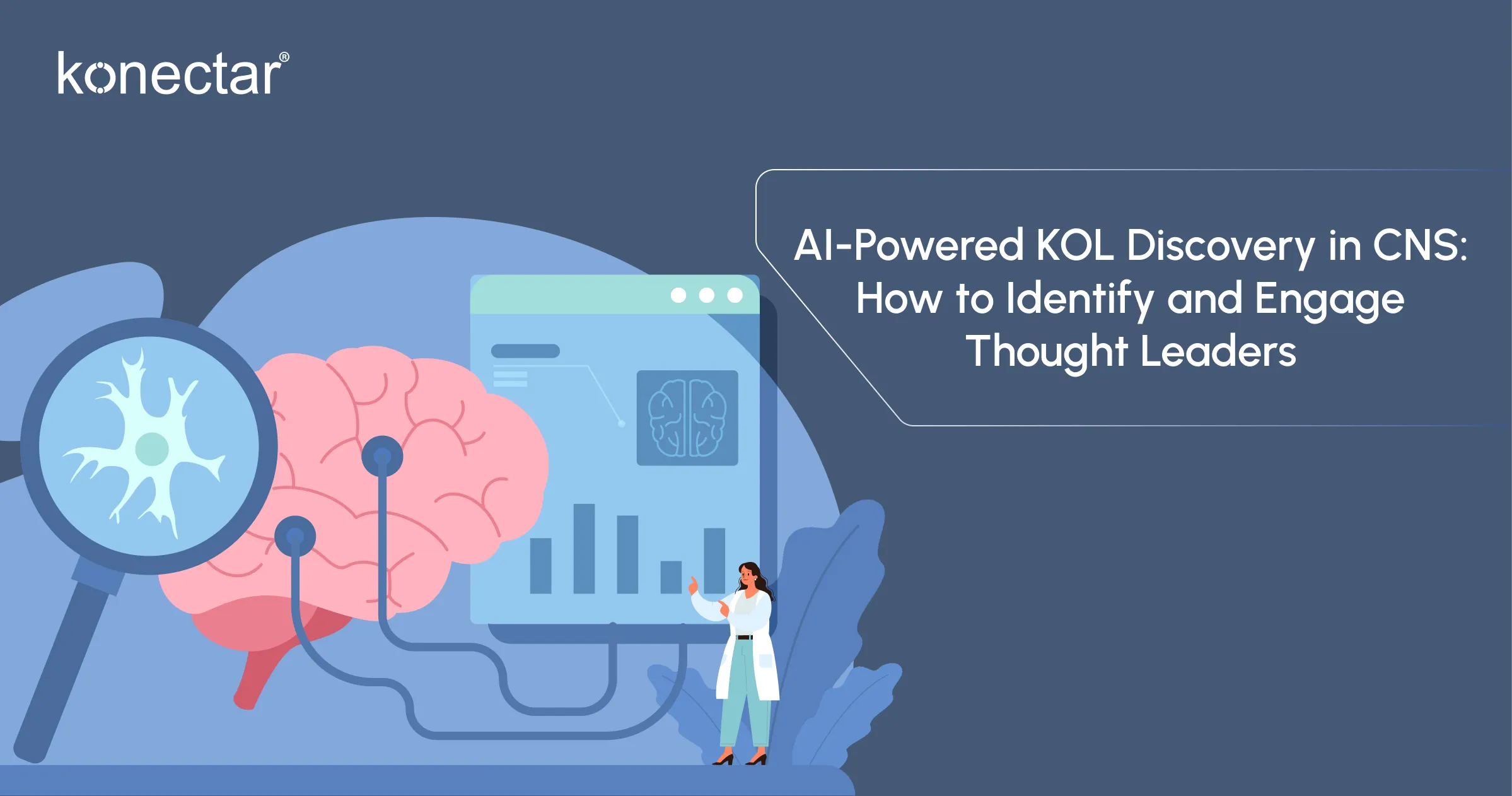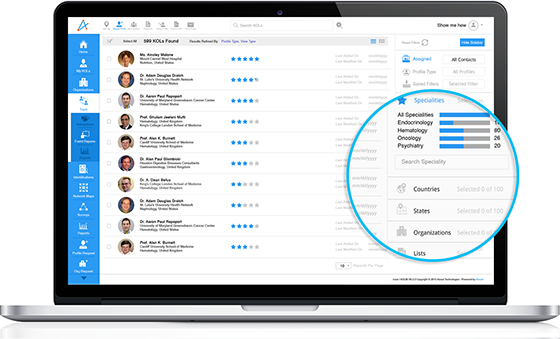13-10-2025
AI-Powered KOL Discovery in CNS: How to Identify and Engage Thought Leaders

The Central Nervous System (CNS) therapeutic area is one of the most complex and fragmented in modern medicine. It spans dozens of sub-specialities, each with its own set of experts, societies, and evolving body of research.
Within these subspecialties, influence is also distributed unevenly. Some Key Opinion Leaders (KOLs) are global thought leaders who shape treatment guidelines, while others serve as local referrals or emerging digital voices that influence day-to-day practice. This fragmentation creates a significant challenge, i.e., the data footprint of KOLs is vast and scattered across multiple channels. Consider the scope:
- Thousands of peer-reviewed publications every year.
- Hundreds of clinical trials are running.
- Global and regional congresses, discussing differing topics.
- Digital presence scattered across professional forums and social media.
The sheer breadth of data can be overwhelming. In this how-to article, we’ll walk through practical steps to discover and prioritize KOLs in CNS using the AI-Powered platform konectar, helping you cut through the noise and focus on what matters in one of the most complex landscapes in healthcare.
Step 1: Start With Clear Objectives
AI can only work best when guided. Define what you need before you start.
- Which CNS disorder or sub-specialty to focus on? (MS, Alzheimer’s, Epilepsy, Parkinson’s)
- Which geography? (Global, National, or Local)
- What is the purpose of engaging these experts? (Advisory boards, speaker programs, trial leaderships)
Tip: This prevents the platform from returning an overwhelming mix of irrelevant experts, helping to narrow them down to manageable lists right away.
Step 2: Aggregate Multi-Source Data
Information on CNS experts is spread across many domains – scientific publications, clinical trial registries, conference abstracts, among many others. Instead of manually working through each one, you can use konectar to scan and aggregate these sources in a structured way.
By aggregating multi-source data, you can connect the dots that would otherwise remain siloed. The result is a rich, unified list of experts that saves you countless hours of research and ensures no key individual is overlooked due to fragmentation.
Step 3: Apply Filters to Focus on Sub-Specialties
Because CNS spans so many fields, raw lists can be overwhelming. This is where filters matter. Using filters can help to refine results by therapeutic area, condition, or specialist type (neurology, psychiatry, etc.)
This granular level of focus can help you drill down to the experts you need. Without filtering, you might end up with a list of hundreds of experts with mixed relevance. Targeted searches dramatically reduce noise and turn overwhelming datasets into short lists you can work with.
konectar has a robust set of filters, categorized in presets. You can either choose preset filters to narrow down your list by top speaker, practitioner, investigator, etc, or make your own lists. The platform features an intelligent tagging system that allows you to handle multiple agendas at once. Define project scope and narrow down your list of experts to a handful of names.
Learn more about KOL profiling and how konectar can unlock actionable insights here.
Step 4: Analyze Profiles for Strategic Fit
Once a list of names has been compiled, the next task is to move beyond surface metrics and understand each expert’s strategic fit. At this stage, you are not collecting names; you are determining which experts align with your goals.
- Review Focus Area: Check the topics of recent publications, congress talks, or trial involvement to see whether they align with your therapeutic priorities. For example, if your goal is to engage experts in Parkinson’s disease, an ideal KOL profile will show multiple related publications or events. konectar shows an aggregated profile that makes it easy to see an expert’s key focus areas at a glance.
Read more about the importance of streamlining speaker selection here.
- Assess Research Trajectory: Examine how their activities have evolved over time. Are they increasing their publications? konectar displays KOLs’ activity at a glance, which is crucial for spotting “rising stars” early.
- Evaluate Collaborations: An expert’s influence is often amplified by their professional networks. Examine authorship status, speaking sessions, institutional ties, engagement ties, etc. Go into detail with referral points by organization and individual, unveiling local “hubs” of influence. Examining these relationships can help you understand an expert’s reach and how you have to engage them.
- Consider Industry Engagement: Another angle of analyzing a profile’s strategic fit is to examine their engagement with the industry at large. Are they being consulted by companies or receiving research grants? An expert whom your competitors highly seek after might be essential for you to know about. By analyzing both academic and industry touchpoints in an expert’s profile, you get a 360° view of their influence and potential fit for your project.
The goal of this deep dive into expert profiles is to move from a list of names to a nuanced understanding of who these individuals are and how they operate within the industry.
Step 5: Segment and Prioritize
Not every KOL has the same influence, and you won’t be able to engage all experts with the same effort. Once you’ve analyzed individual profiles, segment them to make your engagement plan actionable.
- Group by Sub-specialty: Separate KOLs into clusters like neurodegenerative diseases, psychiatric disorders, movement disorders, etc. By grouping experts into groups, you can ensure that your messaging and engagement approach is relevant to each cluster. (In konectar, you can tag or filter experts by their expertise, making these sub-lists easy to maintain).
- Differentiate by Experience: Create two lists of experts – one of influential experts and another of rising experts.
- Match Tiers to Engagement:
- Tier 1: Global or National Leaders → ideal for advisory boards, guideline development, or strategic partnerships.
- Tier 2: Mid-level Experts → suitable for clinical trials, congress symposia, or CME programs.
- Emerging Voices → engage for digital outreach or regional education initiatives.
konectar can assist in prioritization by allowing you to tag KOLs by their tiers. With clear segments and priorities, your KOL engagement strategy becomes intentional and efficient, ensuring that each expert interaction is meaningful for both parties.
Final Thoughts
In a field as intricate as CNS, where information is scattered across multiple touchpoints, finding the right experts can feel like chasing fragments of complete details. The steps you’ve just followed bring structure to that chaos, from defining your focus to analyzing individual profiles to segment them.
AI doesn’t replace human judgment; it can amplify it, highlighting opportunities within the fragmented data. When paired with strategic validation and sincere engagement, it ensures every connection you make is intentional and informed.
So, as the field continues to evolve, treat discovery as an ongoing process – one that blends automation with human efforts. Because in the landscape of CNS, influence isn’t static, and neither should your approach to finding it be. See konectar’s AI-powered discovery in action by requesting a personalized demo.





